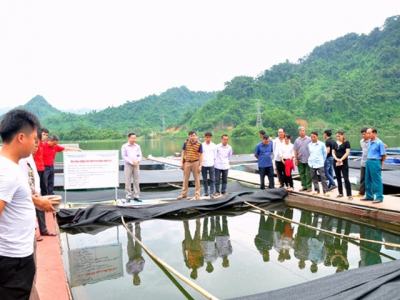Hanoi vicinities- fish farming in combination with rice cultivation

Fish-rice model is bringing high economic efficiency to farmers, proving a new direction of development in organic agriculture development in vicinities.
Fish-rice model: fragrant rice – organic fish
The National Agriculture Extension Center of the Ministry of Agriculture and Rural Development held a forum “Development of fish-rice model for high economic efficiency and sustainability” in Hợp Thanh commune of Mỹ Đức district, Hanoi to disseminate and raise awareness of local farmers about this special aquaculture practice.
According to Kim Văn Tiêu, Deputy Director of the National Agriculture Extension Center, fish-rice practice helps create an ecosystem to bring benefits to both fish and rice. This practice either produces a more abundant crop than the traditional rice cultivation model or takes advantage of surface water to increase output in the same fish farming area.
The development of fish-rice practice is also suggested by experts of the National Agriculture Extension Center to local farmers. So as to reach the highest efficiency from this practice, farmers must combine rotation with intercrop, fish-rice intercrop and one fish crop – one rice crop rotation.
Tilapia and perch are suitable for the fish-rice practice, with a density of 0.5-1 pc/m2 and without feeding. With a density of from 1.5 pcs/m2, feed is needed. Microbiology must be mixed with feed to improve the intestine of fish as it is vulnerable. This will help fish be healthy, weigh up faster and shorten farming duration.
According to experts, fish are easily vulnerable when rice blossoms with leaves falling and making water polluted and disrupting the habitat of fish. It’s time farmers must adopt suitable measures to treat the water environment such as lower the water level, replace water, or use bioproducts. Besides, vitamin C and medicine for disease prevention are advised.
Clear efficiency
The fish-rice model is highly appreciated by farmers in Hợp Thanh commune. Although excavation costs as much as 15-20 percent of the pond area, the total output of rice doesn’t change, even increase. It’s because the fish-rice farm has water which can prevent mice from destroying rice. Besides, carp and tilapia consume apple snails which destroy rice and water in a fish-rice field helps prevent rice from falling in storms. Production cost will decrease with the curtail of chemical substances and pesticide, enhancing efficiency of the model.
Farmer Đinh Đức Hoà, in Hợp Thanh commune of Mỹ Đức district, Hà Nội city has 6ha of fish-rice farm. He has 4 years of experience in applying this model to mainly rear carp, grass carp, and mud carp. He harvested 20 tons of fish in Jan 2020.
He said “I can take advantage of leftovers to feed fish, meanwhile I can harvest higher output than traditional two crops. I earn 250 million profit after production cost from each crop”.
The Hợp Thanh Agriculture Cooperative has an approved 28.39ha of fish-rice farm, with 120ha of harvested area.
Nguyễn Văn Điện, Director of Hợp Thanh Agriculture Cooperative said: “we will finalize procedures to change the harvested area into fish-rice farm”.
“The approved fish-rice farming area has produced stable output, with an average income of 110-130 million/ha/year against the traditional two crop practice in the same field”, said Điện.
Có thể bạn quan tâm
 Vietnamese farming exports reach US$26.1 billion over the past eight months
Vietnamese farming exports reach US$26.1 billion over the past eight months Vietnam's farming exports in the first eight months of 2020 have been estimated at US$26.1 billion, down 0.9% over the same period of 2019.
 Vietnamese agro-forestry-fisheries trade surplus reached US$6.2 billion
Vietnamese agro-forestry-fisheries trade surplus reached US$6.2 billion Vietnamese's import-export turnover reached US$46 billion during the reviewed period, with export and import value dropping by 0.9% and 2.5%
 Hà Tĩnh farmer turns wasteland into farm
Hà Tĩnh farmer turns wasteland into farm Six years ago, Đoàn Văn Hà, 53, residing in Lưu Vĩnh Sơn Commune, Thạch Hà District took a risk and borrowed VNĐ1 billion (US$42,860) from his friends